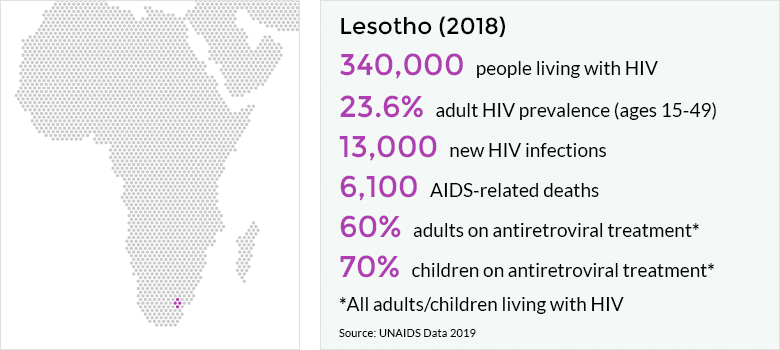Lesotho has reached the second 90 of the UNAIDS targets, with 91.8 percent of people living with HIV who are aware of their status on treatment. It is also close to reaching the third 90, with 87.7 percent of people who are diagnosed and on treatment virally suppressed.
The findings are reported in an analysis of the Lesotho Population-based HIV Impact Assessment (LePHIA) and published ahead-of-print last month in the journal AIDS. LePHIA consists of a nationally representative sample of more than 9,000 households carried out between 2016 and 2017, and charts the country’s HIV epidemic and its progress towards the UNAIDS 90-90-90 targets.
Voluntary home-based HIV testing was conducted and socio-demographic and behavioral risk questions were asked via a questionnaire. For those testing HIV-positive, counselling was provided alongside tests to measure CD4 count and the presence of antiretroviral drugs in the bloodstream. Blood samples were then sent for laboratory testing to confirm viral load.
According to the survey, 25. percent of adults (aged 15–59) were living with HIV in Lesotho, equating to approximately 306,000 people. Overall, women are significantly more likely to be affected, with 30.4 percent of women living with HIV, compared to 20.8 percent of men. HIV prevalence peaks among women between the ages of 35–39 at 49.9 percent and among men between the ages of 40-44 at 46.9 percent. At 1.10 percent, annual HIV incidence among adults remains high and is proof that new infections are still occurring at significant levels.
With just 81 percent of people living with HIV aware of their status, reaching the first 90 is still a way off. This is most notably an issue for younger people (15-34) living with HIV, who were found to be significantly less likely to be aware of their HIV-positive status than other age groups. In fact, the data suggest younger age groups lag behind across all three measures of the treatment cascade.
There is also a significant disparity between HIV-positive men (76.6 percent) and women (84.0 percent) being aware of their status. This means that nearly one-quarter of men living with HIV are unaware of their status, despite extensive community and facility-based testing campaigns to reach this group. Overall, 5.1 percent of the adults testing positive during LePHIA reported never testing before or receiving their results.
The study further indicates that in 2016, Lesotho became the first country in sub-Saharan Africa to adopt the World Health Organization-recommended ‘treat all’ strategy, which enables all people living with HIV to be eligible for treatment, regardless of the level of virus in the body. The jump in treatment coverage reported by LePHIA suggests that the early adoption of this strategy is having a significant impact on treatment access.
However, the testing gap means that, when translated to all people living with HIV in the country, only 67.6 percent of adults living with HIV are virally suppressed, which is below the target level of 73 percent.
Although there is a disparity between men and women in relation to testing, LePHIA found little difference between sexes in regards to treatment access and viral suppression. Around 92 percent of women and 91.6 percent of men diagnosed with HIV are on treatment, and about 87 percent of both men and women on treatment are virally suppressed.
Age was found to be a key factor for viral suppression. Only 78.3 percent of young men and 76.8 percent of young women (aged 15-24) diagnosed with HIV and on treatment are virally suppressed. Viral suppression rates are even lower among adolescent women (aged 15–19) diagnosed with HIV at 50.8 percent and among men aged 25–29 diagnosed with HIV at 43.6 percent.
Migration was also associated with women of all ages being less likely to be aware of their status, and for both men and women to be less likely to be on treatment.
In addition, while treatment coverage is high among adults overall, evidence of low CD4 counts (at <350 cells/μL) in almost half the men and 40 percent of women who were unaware of their HIV-positive status indicates many people with HIV who are undiagnosed are at risk of having advanced HIV.
This suggests that, in addition to closing the HIV testing gap, specific emphasis should be placed on finding HIV positive people earlier and starting them on treatment immediately.








